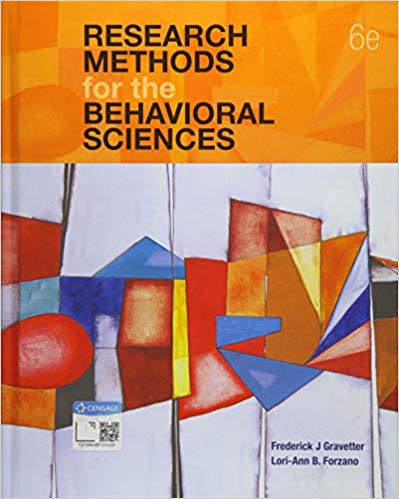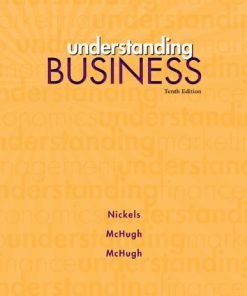Solution Manual for Research Methods for the Behavioral Sciences 6th Edition
$35.00 Original price was: $35.00.$26.50Current price is: $26.50.
Solution Manual for Research Methods for the Behavioral Sciences 6th Edition
Instant download Solution Manual for Research Methods for the Behavioral Sciences 6th Edition digital download immediately after payment is complete pdf docx epub after payment.

Product details:
- ISBN-10 : 1337613312
- ISBN-13 : 978-1337613316
- Author: Frederick Gravetter; Lori-Ann Forzano
See how interesting experimental and nonexperimental research can be with RESEARCH METHODS FOR THE BEHAVIORAL SCIENCES, 6th Edition. Inviting and conversational, the text leads you through the research process from start to finish — using a step-by-step approach that emphasizes the decisions researchers make at each stage. Current research examples are selected to be of particular interest to students like you, and learning objectives help you focus on what’s important. Chapter after chapter, the authors’ “lecture in a book” style delivers clear explanations of topics that make this text easy to read and understand.
Table of contents:
- Chapter 1: Introduction, Acquiring Knowledge, and the Scientific Method
- Chapter Learning Objectives
- Chapter Overview
- 1.1 Methods of Knowing and Acquiring Knowledge
- 1.2 The Scientific Method
- 1.3 The Research Process
- Chapter Summary
- Key Words
- Exercises
- Learning Check Answers
- Chapter 2: Research Ideas and Hypotheses
- Chapter Learning Objectives
- Chapter Overview
- 2.1 Getting Started: Identifying a Topic Area
- 2.2 Searching the Existing Research Literature in a Topic Area
- 2.3 Finding an Idea for a Research Study from a Published Research Article
- 2.4 Using a Research Idea to Form a Hypothesis and Create a Research Study
- Chapter Summary
- Key Words
- Exercises
- Learning Check Answers
- Chapter 3: Defining and Measuring Variables
- Chapter Learning Objectives
- Chapter Overview
- 3.1 Constructs and Operational Definitions
- 3.2 Validity and Reliability of Measurement
- 3.3 Scales of Measurement
- 3.4 Modalities of Measurement
- 3.5 Other Aspects of Measurement
- Chapter Summary
- Key Words
- Exercises
- Learning Check Answers
- Chapter 4: Ethics in Research
- Chapter Learning Objectives
- Chapter Overview
- 4.1 Introduction
- 4.2 Ethical Issues and Human Participants in Research
- 4.3 Ethical Issues and Nonhuman Subjects in Research
- 4.4 Ethical Issues and Scientific Integrity
- Chapter Summary
- Key Words
- Exercises
- Learning Check Answers
- Chapter 5: Selecting Research Participants
- Chapter Learning Objectives
- Chapter Overview
- 5.1 Introduction to Sampling
- 5.2 Probability Sampling Methods
- 5.3 Nonprobability Sampling Methods
- Chapter Summary
- Key Words
- Exercises
- Learning Check Answers
- Chapter 6: Research Strategies and Validity
- Chapter Learning Objectives
- Chapter Overview
- 6.1 Research Strategies
- 6.2 External and Internal Validity
- 6.3 Threats to External Validity
- 6.4 Threats to Internal Validity
- 6.5 More about Internal and External Validity
- Chapter Summary
- Key Words
- Exercises
- Learning Check Answers
- Chapter 7: The Experimental Research Strategy
- Chapter Learning Objectives
- Chapter Overview
- 7.1 Cause-and-Effect Relationships
- 7.2 Distinguishing Elements of an Experiment
- 7.3 Controlling Extraneous Variables
- 7.4 Control Conditions and Manipulation Checks
- 7.5 Increasing External Validity: Simulation and Field Studies
- Chapter Summary
- Key Words
- Exercises
- Learning Check Answers
- Chapter 8: Experimental Designs: Between-Subjects Design
- Chapter Learning Objectives
- Chapter Overview
- 8.1 Introduction to Between-Subjects Experiments
- 8.2 Individual Differences as Confounding Variables
- 8.3 Limiting Confounding by Individual Differences
- 8.4 Individual Differences and Variability
- 8.5 Other Threats to Internal Validity of Between-Subjects Experimental Designs
- 8.6 Applications and Statistical Analyses of Between-Subjects Designs
- Chapter Summary
- Key Words
- Exercises
- Learning Check Answers
- Chapter 9: Experimental Designs: Within-Subjects Design
- Chapter Learning Objectives
- Chapter Overview
- 9.1 Within-Subjects Experiments and Internal Validity
- 9.2 Dealing with Time-Related Threats and Order Effects
- 9.3 Comparing Within-Subjects and Between-Subjects Designs
- 9.4 Applications and Statistical Analysis of Within-Subjects Designs
- Chapter Summary
- Key Words
- Exercises
- Learning Check Answers
- Chapter 10: The Nonexperimental and Quasi-Experimental Strategies: Nonequivalent Group, Pre-Post, an
- Chapter Learning Objectives
- Chapter Overview
- 10.1 Nonexperimental and Quasi-Experimental Research Strategies
- 10.2 Between-Subjects Nonexperimental and Quasi-Experimental Designs: Nonequivalent Group Designs
- 10.3 Within-Subjects Nonexperimental and Quasi-Experimental Designs: Pre-Post Designs
- 10.4 Developmental Research Designs
- 10.5 Applications, Statistical Analysis, and Terminology for Nonexperimental, Quasi-Experimental, an
- Chapter Summary
- Key Words
- Exercises
- Learning Check Answers
- Chapter 11: Factorial Designs
- Chapter Learning Objectives
- Chapter Overview
- 11.1 Introduction to Factorial Designs
- 11.2 Main Effects and Interactions
- 11.3 Types of Factorial Designs and Analysis
- 11.4 Applications of Factorial Designs
- Chapter Summary
- Key Words
- Exercises
- Learning Check Answers
- Chapter 12: The Correlational Research Strategy
- Chapter Learning Objectives
- Chapter Overview
- 12.1 An Introduction to Correlational Research
- 12.2 The Data and Statistical Analysis for Correlational Studies
- 12.3 Applications of the Correlational Strategy
- 12.4 Strengths and Weaknesses of the Correlational Research Strategy
- Chapter Summary
- Key Words
- Exercises
- Learning Check Answers
- Chapter 13: The Descriptive Research Strategy
- Chapter Learning Objectives
- Chapter Overview
- 13.1 An Introduction to Descriptive Research
- 13.2 The Observational Research Design
- 13.3 The Survey Research Design
- 13.4 The Case Study Design
- Chapter Summary
- Key Words
- Exercises
- Learning Check Answers
- Chapter 14: Single-Case Experimental Research Designs
- Chapter Learning Objectives
- Chapter Overview
- 14.1 Introduction
- 14.2 Phases and Phase Changes
- 14.3 Reversal Designs: ABAB and Variations
- 14.4 Multiple-Baseline Designs
- 14.5 General Strengths and Weaknesses of Single-Case Designs
- Chapter Summary
- Key Words
- Exercises
- Learning Check Answers
- Chapter 15: Statistical Evaluation of Data
- Chapter Learning Objectives
- Chapter Overview
- 15.1 The Role of Statistics in the Research Process
- 15.2 Descriptive Statistics
- 15.3 Inferential Statistics
- 15.4 Finding the Right Statistics for Your Data
- 15.5 Special Statistics for Research
- Chapter Summary
- Key Words
- Exercises
- Learning Check Answers
- Chapter 16: Writing an APA-Style Research Report
- Chapter Learning Objectives
- Chapter Overview
- 16.1 The Goal of a Research Report
- 16.2 General APA Guidelines for Writing Style and Format
- 16.3 The Elements of an APA-Style Research Report
- 16.4 Writing a Research Proposal
- Chapter Summary
- Key Words
- Exercises
- Learning Check Answers
- Appendices
- Glossary
- References
- Name Index
- Subject Index
People also search:
Research Methods for the Behavioral Sciences 6th Edition
Research Methods for the Behavioral Sciences 6th Edition pdf
Research Methods for the Behavioral Sciences
|
research methods in the behavioral sciences
|
what is behavioral science research
what is the importance of research in behavioral sciences
Related products
Solution Manual
Management Information Systems Managing the Digital Firm Laudon 14th Edition Solutions Manual
Solution Manual
Solution Manual for Introduction to Robotics Mechanics and Control 3rd Edition by Craig
Solution Manual
International Accounting Doupnik 4th Edition Solutions Manual
Solution Manual
International Business Competing in the Global Marketplace Hill 10th Edition Solutions Manual
Solution Manual
Understanding Business Nickels 10th Edition Solutions Manual











